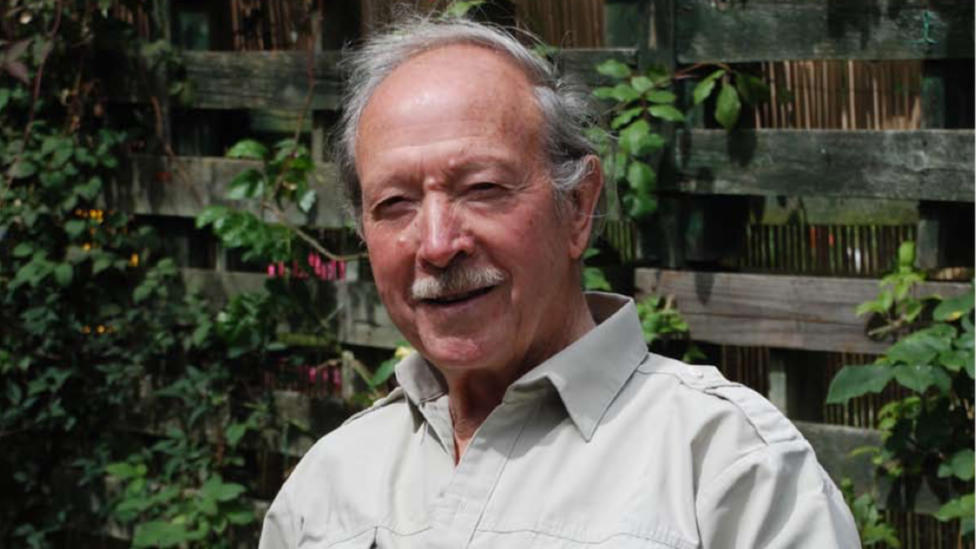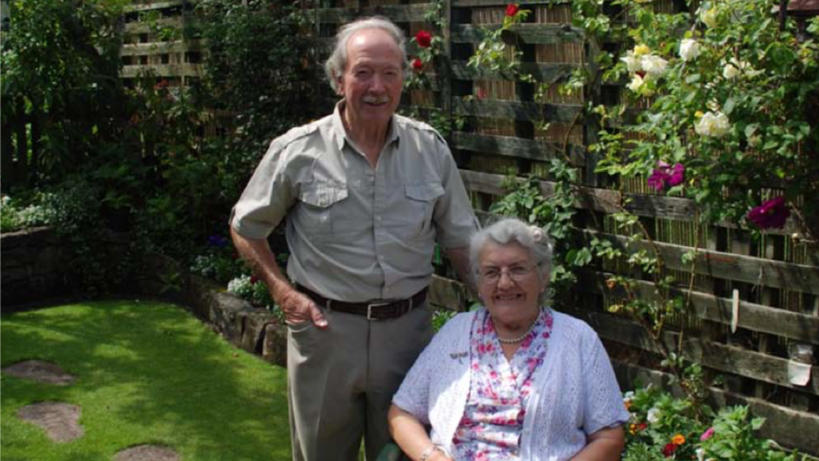- Homepage
- News and Features
- Obituary: Cecil George, the ‘man o’ mony pairts’
Obituary: Cecil George, the ‘man o’ mony pairts’

Cecil George pictured in 2010
Cecil George, BIGGA life member and former chairman of SIGGA, died aged 91 on Friday 18 January, dressed in his beloved BIGGA polo neck t-shirt.
Christened the ‘man o’ mony pairts’ by Elliott Small, a fellow former BIGGA chairman and life member, Cecil has been credited with doing more to progress the education of greenkeepers than any other.
Born on 23 January 1927, Cecil first got into greenkeeping as a 15-year-old, joining the staff at Whitecraigs near Glasgow in 1943.
Speaking in 2010, Cecil said: “I started out as a gardener, working for my uncle. But at the end of my first summer he told me that I’d be finishing at the end of the week as there wasn’t enough work for me. To lessen the blow, he gave me tu’pence and told me to go to the big white house and ask for a lemonade. I knew that the building was Whitecraigs Golf Club and as I drank the lemonade – they wanted the bottle back – I chatted to the man who asked me what I was doing. When I told him my uncle had just sacked me, he told me that there was a job going at the club for a greenkeeper.”
The Second World War interceded and when he came of age Cecil spent four months with the Cameron Highlanders before joining the Parachute Regiment. Although the end of the war in Europe prevented any deployment there, he did see action in the Middle East, undertaking 109 jumps, many from as low as 500 feet.
Afterwards he returned to Glasgow, where he interviewed for an engineer’s job and was told that if he returned the following day, there would be a job waiting for him. That evening he visited the pub, where he bumped into the head greenkeeper at Whitecraigs, who persuaded him that if he was to go back to the course, he would enjoy it much more.
“I went up, had a go on one of the machines and was hooked. If I hadn’t met him that night, I’d have become an engineer and wouldn’t have been here talking to you,” Cecil explained.
Now in greenkeeping for the long haul, Cecil made his way up through the profession via roles at Fereneze and Cathcart Castle, before finally settling at Lenzie in Dunbartonshire in 1954. He would remain there for 37 years, until his retirement in 1991.
In those early years, golf wouldn’t start until around 4pm and weekend medals didn’t start until noon. Cecil received a salary of £8.10 a week and the annual subscription to be a member at Lenzie was £5.
Greenkeeping was a very different profession back then, when there was a lack of understanding about the environmental impact of practices, not just on the course but across the amenity and agricultural sectors.
In a letter sent to BIGGA’s magazine, Greenkeeper International, in 2017, Cecil wrote: “I do agree that some of the most dangerous chemicals we used in the past were long overdue to be stopped. I often wonder, as one who has used most of the mercurial fungicides, lead arsenic, sulphur and others, just what dreadful, everlasting damage we did to nature. Why did we not recognise or even notice what was happening under our noses?”
Arriving at Lenzie, Cecil undertook a renovation of the course that saw him plant 10,000 trees. With the greens comprising around 80% moss, a programme of scarification “tore the greens to pieces” and transformed them to the extent that when he left in 1991, the greens were 90% bents.
The site of a former loch, Lenzie was kept dry by a 200-year-old tunnel, although collapses and silt build-up did mean portions of the course would flood in exceptionally wet weather.
Writing in 2001, Cecil said: “One night, after my day’s toil on the course and during a very wet period, I was having my usual refreshment in the bar when one of our members rushed in and breathlessly told us that ‘they’ were pumping out the loch.”
It emerged that ‘they’ were the fire brigade and after an excited conversation where Cecil insisted no one could pump that amount of water from a loch, but the eye witness claiming that was the case, Cecil jumped into his car to find out exactly what was taking place.
“I arrived to see the fire brigade clearing up their hose pipes. They had been requested by the police to clear the drainage system, which was blocked and causing the road to flood. I told him that one of our members had just come into the clubhouse and said they were pumping out the loch. We looked down the loch, and looked at his equipment, and we both just laughed.”
While undertaking night school at Glasgow Horticultural College for two years to gain his Certificate in Horticulture, Cecil began to muse about how improved education could help to raise the stature of the greenkeeping profession. It was a passion for education that would last for the rest of his life.
In the 1960s Cecil set up the first ever training courses for apprentice greenkeepers at Glasgow’s Woodburn House, working with Bob Moffat to teach and examine the students.
The pair worked with City & Guilds to gain accreditation and worked to establish a single curriculum across Scotland’s five main college. This was followed by the development of a HNC, working with Woodburn House and Elmwood Collage. That was a six-year process, from inception to completion, but once established it was quickly followed by the introduction of a HND.
A member of BIGGA and its predecessors, the SGCA and SIGGA, throughout his entire career, Cecil became education convenor for the association’s West Section. He then took upon the role of education convenor for SIGGA, before playing an instrumental role in the formation of and then being appointed Scottish Region Chairman of The Liaison Committee, working alongside the five Scottish colleges.

Cecil and Margaret George pictured in 2010
In 1972 he represented Scotland at the first European Greenkeepers Conference in Switzerland in 1972 and was the Scottish representative of the Greenkeeper Training Committee from 1986 until his retirement.
Other notable successes throughout his career included becoming SIGGA president in 1960 and again in 1970. In 1973 he captained the victorious Scottish team at the first Ransomes International. He was also appointed vice president in 1974, the same year he acted as editor of Turfcraft, the SIGGA publication.
Continuing that interest in printed publications, in 1987 Cecil joined the panel tasked with forming a single magazine across BIGGA, leading to the establishment of Greenkeeper International.
He also sat on the interview panel for the association’s first executive director, Neil Thomas.
Elliott Small once described the contribution Cecil made to greenkeeper training as “gigantic”, with Cecil himself stating: “What I always strived for was better wages. If we got better wages we’d get better men and better students. With better greenkeepers we’d get better golf course.”
Cecil remained at Lenzie for the remainder of his career, although he did come close to getting the head role at St Andrews Links when Walter Woods was appointed.
Upon his retirement in 1991, Cecil was recognised by many from across the industry. The following year Alistair Connell, the West Section’s chairman, presented him with crystal glass on behalf of the section.
Gordon Kerr, writing in Around the Green, described Cecil as one of the few characters left in greenkeeping, stating he was a stalwart not just for the section, but also greenkeeping in general.
Jokingly, Gordon added: “I would point out to you all that despite Cecil’s immense involvement with the association, there is no truth in the rumour that he arrived on Monday morning to give instructions to his assistant for the week ahead and arrived back on Friday evening in the gentlemen’s bar to discuss with the committee how difficult the week had been! Cecil did not get to where he is today without doing his fair share of hard graft, especially in trying to drain Lenzie over the past 37 years!”
Cecil was made a life member of BIGGA in 2010. Upon hearing that Walter Woods would be making the presentation in 2010, Cecil was said to have muttered: “Och, it’ll be nice to actually get something out of the old so-and-so for a change!”
A hitherto-unachieved aim of Cecil’s was for the BIGGA to have its own golf course, with him even picking out the stretch of North Yorkshire coastline between Scarborough and Bridlington as prime for a links venue operated by the association.
“We have over 6,000 members, yet we don’t have a golf course of our own?” Cecil said upon the establishment of the BIGGA Golf Course Fund in 2008. “Don’t you think that’s peculiar – an association of greenkeepers without a course?”
The ambition is long-standing but unfulfilled, with the association choosing instead to direct its fundraising efforts towards the BIGGA Greenkeepers Benevolent Fund, which Cecil wholeheartedly supported.
Cecil’s final award was the 2018 Walter Woods Lifetime Achievement Award, presented to him at the BIGGA Scotland Awards Lunch on 5 December 2018.
The betterment of the greenkeeping profession was at the heart of everything Cecil did. Throughout his career and then his retirement, Cecil sought to improve educational opportunities for the next generation. He was quick to offer advice of his own, believing that sharing the knowledge gained over years of experience was the duty of the veteran course manager.
Writing upon the death of his friend Robert MacDougall in 2003, Cecil said: “It is to our detriment as greenkeepers that the older members of our profession pass on and take their knowledge and skills, acquired over a lifetime, with them… I do not believe that when we die everything goes out the window. I do believe there is a Heaven. That being the case, there is bound to be a good golf course where there will be many old friends to meet and scud a ball or two.”
Cecil is survived by his wife Margaret and children Lorna, Lynn and Ken.
Author

Karl Hansell
Karl has been head of communications for BIGGA since March 2016. His duties include editing the monthly Greenkeeper International magazine, in addition to other communications activities for the association.
